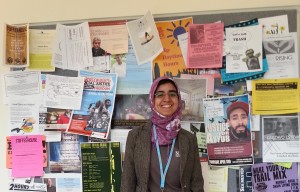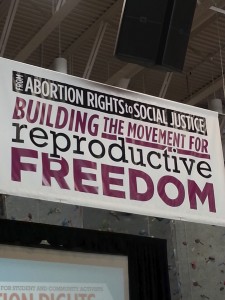The 2014 Civil Liberities and Public Policy Conference
This post was written by Ayesha Rehman, a junior at Macaulay Honors College at CUNY and the Reproductive Health Access Project’s research intern. Every year RHAP sponsors our interns to attend the Civil Liberties and Public Policy conference at Hampshire College. This year we asked Ayesha to document her experience at the conference and share her thoughts on our blog.
Day 1, April 11, 2013
After a long bus ride, my friend and I finally arrived at Hampshire College for the 2014 CLPP Conference. The first workshop that we attended was called Deconstructing the Good Mother Myth. The panel consisted of 5 people – Avital Norman Nathman, Deborah Jiang Stien, Sarah Buttenwieser, Natasha Vianna, and Tope Fadiran Charlton. Each panelist had a unique story, but the two that made me think the most were Natasha and Deborah’s narratives. Before attending the workshop, I admit that I always perceived teen pregnancy as a negative thing. I had the belief that teen moms are often not able to care for their children because they are still high school students who can only manage to get minimum-wage jobs. While the reality might be grim for many teenage moms, it is not always the case. Natasha, a mother who became pregnant when she was 17, shared how she grew to be more resilient by having the chance to be a mother. She had to transfer from her unsupportive Catholic school to a public school- where there was a day care. She said it was the attitude of the surrounding people that was hard to deal with. Natasha completed high school and went on to get a college education, but again the uncooperative approach of people around her made life difficult. Society often promotes the notion of delayed parenthood as the right choice, but at the end of the day, it falls on each person to decide when to become a responsible and caring parent. The other speaker who touched me was Deborah, an adoptee born in prison. She shared how women who are incarcerated are denied basic human rights when it comes to fulfilling their right to be a mother. From being shackled during labor to not having legal custody of their children, women in prisons are treated as if they don’t deserve to be mothers. I became so interested in this topic that I went to another workshop called Invisible: Women in America’s Prisons and Jails on Saturday that delved into it more deeply. More on this in Day 2.
Day 2, April 12, 2013
Saturday’s opening plenary consisted of brief presentations by organizations that are working for reproductive justice throughout the country. From the upbeat performance of Joe Scott’s song Golden by Monica Simpson of SisterSong to poems read by activists, the day started with vibrant energy. The first workshop I went to was called Self Cervical Exam: Abortion, Menstrual Stories, Birth Control, and Self Examination As Tools for Self-Determination. I was curious to find out about the self-exam. But I came to the conclusion that learning such a skill is not of much use to me. I do not think that knowing what color the lining of one’s cervix is helpful in telling anything. I believe it is best to consult a clinician when it comes to taking care of one’s reproductive health. The second workshop was on the violation of female prisoners’ reproductive rights. The panelists talked about the conditions of jails in Massachusetts, but I assume the circumstances are not much different in other parts of the United States. Visitors have no rights as they are sniffed by dogs and made to wait long hours. These actions are taken to dissuade people from visiting, so that inhumane treatments like female inmates being stripped in presence of four or five male guards may go unnoticed and ignored. An incarcerated mother who gave birth to her son while shackled spoke of the unnecessary and cruel practice of restraint during labor. She explained how officers at the facility did not believe her when she said she was going into labor and so she was not taken to the hospital on time. From her story, I saw how organizing a campaign with media coverage can move anti-shackling bills forward and shed light on the barbaric treatment that is practiced in prisons. If an anti-shackling bill passes in Massachusetts, it will be the 19th state where imprisoned women can safely give birth just like any other mother. The last workshop for the day was Organizing for Reproductive Justice in Religious Communities. The main theme that I took away was that if you want to bring reproductive justice into the conversation among religious people, you have to start small. You can begin by talking to a close friend or family member and instead of pinpointing who is opposing your ideas, try and find allies. This makes it easier to move your goal forward. This strategy is very relevant to activists who want to discuss abortion rights because 87% of U.S. population has some sort of religious beliefs. Another important thing that the panelists discussed was recognizing our own limits. For instance, if you feel that abortion is permissible but later-term abortion doesn’t align with your own beliefs, then advocating for all abortions might be problematic. All in all, I learned there is no one-way to reconcile religious beliefs with reproductive justice. But we can find answers by beginning to talk to people with the same position.
Day 3, April 13, 2013
The workshop I went to on Sunday explored environmental and climate justice. I was interested in how the panelists – Asa Needle and Jacqui Patterson – were going to relate environmental issues to reproductive justice. Sure enough, the advocacy agenda of Injustice Anywhere is a Threat to Justice Everywhere became clear when they discussed how landfills are almost always located in communities of color and low-income populations. Harmful chemicals and carcinogens that seep into the water supply can mean disaster for everyone, from children to pregnant women. The panelists mentioned how one African American community was not informed about landfill pollution that was happening in their vicinity and as a result, people in that community consumed contaminated water for a year! This is also true for other facilities that are known to emit toxic residue. For instance, besides having a sewage treatment plant and health-hazardous-particulates-puffing bus depots, there are plans of building research labs with security clearance for highly dangerous substances such as anthrax in Harlem, which has the densest African population in the world after Africa. Factors like these play major roles in the overall health of the people in these communities. From harmful mutations in babies to higher asthma prevalence, the health of some social classes is being knowingly compromised. This has to be stopped. One way to do so is by informing more people and starting a conversation about the problem. I am glad I was able to attend the 2014 CLPP conference and go beyond just the facts, like how the U.S. constitutes 4% of the world’s population but emits 25% of carbon gases. There is so much more to the discrepancy than the numbers show and I was able to learn and talk about important issues at the conference.


